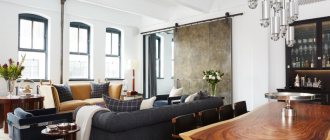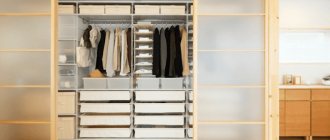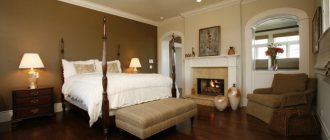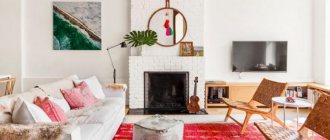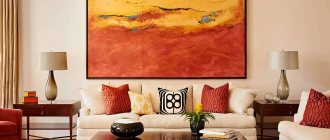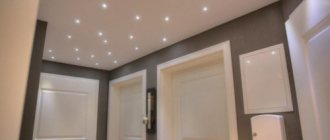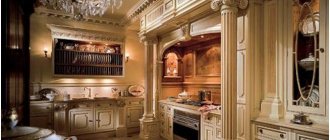An aquarium is a wonderful decorative element for a living space. An unexpected, mysterious, contrasting accent can enliven even the most boring and banal interior. On the one hand, aquariums bring a certain dynamics to the environment, since the creatures inhabiting them are in almost continuous motion. On the other hand, they have an amazing ability to create a calm and peaceful atmosphere in the house. Watching the fish, you forget about all your worries and sorrows, you calm down, you regain harmony with yourself and with the world. Among the chaos and bustle, you really want to have your own little oasis!
How to beautifully “fit” a live aquarium into the kitchen interior ↑
Traditionally, aquariums are placed in the living room. Much less often they become a beautiful and intriguing element of the decor of other rooms in the house. You would be very pleasantly surprised to see an aquarium built right into the shower, or an unusual headboard in the shape of an aquarium. What about an aquarium in the kitchen interior?! This option is also possible! A great alternative to TV in the kitchen! Why spoil the appetite of yourself and your loved ones with bad news and low-grade TV series, when you can spend hours on end admiring the unique “live TV programs”. The most interesting thing is that this activity never becomes boring or boring. An aquarium is a small piece of another world, and it is always fascinating!
One of the most convenient solutions is to build an aquarium into the kitchen wall or integrate it into the structure of a functional kitchen unit
For a kitchen interior, an aquarium is, of course, an unexpected solution, but if you like the idea of living decor, you can always find ways to implement it if you wish. You can use an aquarium in your kitchen interior design in different ways. One of the most convenient solutions is to build an aquarium into the kitchen wall or integrate it into the structure of a functional kitchen unit. In the design of a spacious, ultra-modern kitchen, a kitchen island with a base in the form of a large aquarium will look great. If the kitchen has a bar, the aquarium can be built directly into the base of the bar counter or used as a scenic backdrop. To create an exclusive and stylish kitchen interior, it is not at all necessary that the aquarium be huge.
Watching the fish, you forget about all your worries and sorrows, you calm down, you regain harmony with yourself and with the world
Original ideas: how to fit an aquarium into the living room interior
We suggest approaching the organization of an aquarium in the living room with a creative approach. The main rule: do not make a piece of furniture out of it. The aquarium should serve as a multifunctional art object. How not to make a box of fish out of it, see below.
Large built-in aquarium in the form of a painting for the living room
Aquarium-column in the living room interior
The cylindrical aquarium fits well into a column. It can serve as a piece for zoning the living room. If you have some interesting item that looks great in water, then be sure to make such a display case in the room.
Aquarium-column in the interior of a modern living room
Ceiling aquarium in the living room interior
Hang the aquarium from the ceiling. Narrow models are used for this. Such aquariums can serve as a decorative partition between the first and second tiers in the living room. Also use a ceiling aquarium as an alternative light source.
Aquarium built into the ceiling of the living room
Art object from an aquarium in the living room interior
Give your living room a one-of-a-kind decoration. Surely everyone has an old TV in their garage? Take its body, install an aquarium in it according to the size, and you are ready for a budget but stylish art object to decorate your living room. All your guests will be delighted with such an original idea.
Aquarium for the living room in the case of an old TV
Aquarium in the closet
Residents of one-room apartments have to place storage cabinets in their living rooms. So, so that you don’t get bored with this piece of furniture, order a custom-made cabinet with a built-in aquarium in the middle across the entire width. And his lamp will serve as a backlight for all shelves.
Aquarium built into the cabinet facade
Window-aquarium in the living room interior
Make a window in the next room and install an aquarium in its opening. This will help create an amazing atmosphere in the apartment.
Aquarium in a niche in the living room interior
Aquarium clock in the living room interior
Place a small aquarium in the wall clock case. This will be an interesting solution for decorating your living room.
Correctly fitting an aquarium into the living room interior is an art. Unfortunately, it is not available to everyone. But with the right choice of shapes and sizes, taking into account all the recommendations and ideas given, you can try to make your dream of an aquarium in the room come true.
Which aquarium to choose for the kitchen ↑
- Freestanding aquariums
The main advantage of a free-standing aquarium is high mobility and ease of maintenance. You can place such an aquarium on a special stand or directly on the floor. The stand in the form of a bedside table is very convenient for placing fish food and all the accessories necessary for maintaining and caring for the aquarium. The shape of a free-standing aquarium can be very diverse, ranging from a standard circle or rectangle to fancy unusual and irregular shapes. The curvature of the glass can follow the curves of furniture or walls, and the original design of the stand and lamp will make the aquarium a bright accent of the interior. An aquarium-picture, the size of which can be selected individually, will be a wonderful wall decoration.
Kitchen island with aquarium
- Built-in aquariums
Built-in aquariums can serve as part of an interior partition, be mounted in a niche or directly into the furniture itself. The depth of such aquariums, as a rule, is no more than 35 cm, while the length can reach 3 meters. To create a cozy, peaceful atmosphere in the room, it is not at all necessary to populate the aquarium with fish; it is quite enough to imitate a rocky seabed using sea pebbles, add shells, stars and sprigs of elodea. An aquarium with such filling requires minimal maintenance. An aquarium built into the partition will look great in a studio layout on the border between the kitchen and living room.
A “living” apron in the sink area turns dishwashing into your favorite pastime!
In this case, the reservoir is made transparent on two or even three sides. If you want to have fish in such an aquarium, you should choose the carp or silverside family, which are famous for their resistance to stress, and therefore will not hide from people passing by. To conveniently change water, there should be free space above such an aquarium of at least half the height of the built-in aquarium. You can hide this place with a removable decorative panel.
Types of installation of aquariums for living room interiors
Before purchasing an aquarium, it is worth learning in detail about the design features of each existing model.
Large aquarium on the entire wall in the living room
Floor aquarium in the living room interior
This type of aquarium is installed on a special stand or on the floor. If desired, you can always move it to another place, thereby constantly changing the design of the room.
Small floor-standing aquarium in the living room
One big disadvantage of such models is their large size. Such aquariums are not suitable for living rooms with compact dimensions. You need to prepare a lot of free space to install it.
Aquarium installed on a stand
Before purchasing a floor-standing aquarium for your living room, pay special attention to its strength and stability.
Built-in aquarium for a niche in the living room interior
If your living room is combined with a bedroom, then there is probably a partition installed in the room. You can install a built-in aquarium in such a decorative niche.
Aquarium built into a niche
This design solution will originally divide the living room into zones and become an interesting decoration.
The aquarium separates the living room from the kitchen
A built-in aquarium can be installed in a free wall in the living room. At the same time, it is completely recessed inside. If your living room is made in a classic style, then order a baguette for the aquarium. The result will be a painting with a living image.
Aquarium partition in the interior of the living room
Believe it or not, you can install an aquarium not only in a niche or wall. For the most daring interiors, it is proposed to make an aquarium in the floor. It will become a bright highlight in your living room. Many people keep only plants in aquariums.
Built-in aquarium for furniture in the living room interior
An equally interesting design solution would be to install an aquarium in a piece of furniture. It could be:
- coffee table;
- TV stand;
- wall.
Aquarium built into a coffee table for the living room
This design is truly considered an interesting option and should be considered for decorating the living room.
Large dining table for living room
If possible, connect the living room with the dining room, and add a dining table made of clear glass as decoration. The highlight of this furniture will be the aquarium located below. Now your feasts will be more festive. This accessory is suitable for both a city apartment and a private house.
Living room in a classic style with an aquarium in the interior
Corner aquarium in the living room interior
The design of such an aquarium allows you to create a wide panoramic view in the living room, demonstrating to all guests the richness of your personal underwater world. Caring for a corner aquarium is much easier than for built-in models.
Diorama in the living room interior
If you're looking for original decor for your country home living room, consider a diorama. The design has a convex front wall of the aquarium, thus creating complete immersion in the underwater world.
Aquarium with a convex front wall for the living room
Non-standard forms of aquariums in the living room interior
If you are a lover of everything original and extraordinary, then choose a suitable aquarium to decorate your living room. The emphasis can be made with a round aquarium placed on a hill. To do this, install a column in the middle of the room and place an aquarium on it.
Aquarium built into the closet for the living room interior
If your living room is of impressive size, install a billiard table in it, with an aquarium mounted inside.
Aquarium built into the wall
You can also add an original aquarium as a canopy at the head of the sofa.
Aquarium at the head of the sofa
Options for placing an aquarium in the kitchen ↑
Aquarium in the wall between the kitchen and dining/living room ↑
The wall between the kitchen and the dining room once caused trouble, since it was necessarily load-bearing, and therefore prohibited from demolition. We had to look for compromises (arched openings, columns). Combining the kitchen and dining room was turning into a nightmare.
Today there are simply no walls, and rightly so - the opportunity opens up to arrange the room according to your own wishes. Some people prefer a common space, while others frankly need not only actual zoning (kitchen furniture here, sofa here), but also visual ones. You can build a partition, but why? An aquarium is a simple (except for caring for its inhabitants) and original solution. Moreover, this solution will never become hackneyed - it is flexible. With the help of lighting alone, you can change the look of the kitchen-dining room at least every hour.
A huge aquarium needs to be placed on something - tables with drawers are optimal: it’s convenient, and there are additional places to store all sorts of things. The cabinets are hung on top - the structure is ready. It is not solid, there is no wall as such, but the impression is there. However, you can ignore the utilitarian function if space allows.
The aquarium does not have to be huge - it will play its role as a wall separating the kitchen from the dining room in any case.
We do not recommend keeping fish or plants in such an aquarium - caring for them will be incredibly burdensome. For each feeding, you will have to jump on a stepladder and perform ballet steps in order to feed the pets through the upper cabinets (of course, there is nothing in them). Now let’s try to imagine the water change...
An aquarium without fish looks no worse.
Aquarium without fish
There are fish in the photographs, but in this case the aquariums are put on permanent maintenance, that is, a special person comes and maneuvers through the cabinets for as long as necessary. If it is possible to pay employees, then you can let the beauties swim.
Aquarium in symbiosis with kitchen furniture ↑
And this is real. Of course, for a small kitchen, where there are some utensils on every centimeter of the wall, this is an unaffordable luxury, but in rooms with enough square footage for a kitchen island you can already create.
Aquarium in the table
And the creations can even be classified as eco-chic style. Robert Kolenik (we consider his work as an example) specializes in this area. The master uses only natural, harmless materials. Chic is chic, but Robert does not forget about functionality. The tabletop installed above the aquarium rises with “one click”: you just press a button and access to the aquarium is open. It is clear that such masterpieces are made exclusively to order.
And we immediately move on - an aquarium in symbiosis with a bar counter.
Aquarium in symbiosis with a bar counter
When arranging it, you need to take care of the light, so the tabletop is not mounted directly above the aquarium. It is first covered with a special lid with lamps. But this is when there are live fish and plants in the aquarium. If none are observed, calmly ignore the lighting requirements.
Aquarium in the kitchen
However, the lighting itself should not be ignored. Lamps will still be needed so that the aquarium does not overtake the gopher by stealth.
Aquarium table
An excellent option for the dining room is an aquarium table.
Little things in kitchen life ↑
Manufacturers of skins love to exploit the marine theme - it is very harmonious with glass. Let's go the opposite way - we threw off the aquarium instead.
Constantly changing temperatures near the working surface are not the best conditions for fish, but you can do just fine without them - set up an aquarium with artificial contents (since plants will not enjoy the pandemonium around the burners either). Fortunately, they are now making algae and other coral leaves that are indistinguishable from real ones.
How about an aquarium shell? I would like to immediately give the designer a medal. Even two pieces.
And don’t forget about the basics - dot inclusions are always good. There is definitely a place in the kitchen for a small aquarium.
There are often theses about the exotic nature of kitchen aquariums, but, in our opinion, there is nothing exotic about them. Water is a related medium to all living things. Foremother. Nurse. We prepare food (and we can’t live without it) in the kitchen.
You can look at the water endlessly. But it is worth considering the movement. You need to understand what you really want - minutes of quiet contemplation or watching the flickering of colorful fish.
We skip the manual for building an aquarium with our own hands (it will still turn out to be a freak, and it’s difficult), we take for granted the need to purchase the required container and move on to filling it.
Location of the aquarium in the interior of the apartment
When planning to install an aquarium in an apartment, you should remember that a boring glass cube placed in the farthest corner will not decorate the room.
Nowadays, enormous opportunities are opening up to create a truly interesting art object, planning it even at the stage of creating an apartment design project. It is proper planning that can solve issues of beauty and functionality of the aquarium, and help solve simple requirements, such as ease of caring for fish, the problem of lighting, water and air supply.
Before deciding what kind of aquarium you want to see in the interior design, first of all you should decide for which area of the apartment it is intended.
Aquarium in the living room
In the living room, it should first of all attract guests, be bright, solid and impressive, and also visually expand the room.
It can be located in different ways:
- Aquarium cabinets are one of the standard options that can be moved, since they are a separate, not built-in piece of furniture.
- “Column” - has its own specific area in the center of the living room, accessible from all sides. All communications are hidden behind secret panels.
- The option built into the wall looks like a living picture on the wall, because it is installed flush with it and is laid out on the construction plan with hidden connections for all communications and special doors on the other side for maintenance.
- Built into a partition is almost the same as built into a wall, the difference is that in addition to its own decorative component, it also helps zoning the living room space.
Aquarium in the children's interior
In the nursery, it is intended primarily to introduce the child to the underwater world. It is advisable that he have the opportunity to feed the fish himself and see them during daily activities. Therefore, when planning the design of a nursery for boys, the aquarium should be placed not far from the desktop in a niche or a special cabinet to eliminate the risk of injury.
It’s even easier to decide on the size: too small or vice versa, large aquariums will be difficult to keep constantly clean, so the optimal choice would be a 20-30 liter capacity.
To create an interesting spectacle for a child, you should not waste time on decoration - let there be an interesting fish house or a model of a sunken ship at the bottom of the aquarium.
Aquarium in the kitchen
If you spend a lot of time in the kitchen, why not put an aquarium there too? There are a few rules to consider:
- Do not place the aquarium near the cooking zone - a large amount of heat and fumes released during cooking will not benefit the fish.
- You shouldn’t get carried away with the fashion fad, which looks so impressive in the photo, and turn it into a podium for the table - it will still be impossible to clearly see the fish, and the chance of breaking even tempered glass is very high.
- The ideal location for the aquarium is near the sink, close to all communications; the most advantageous location for the aquarium would be to embed it into the wall as a kitchen apron. You can admire the fish while cooking, and no one will harm them. The only thing is to provide for the possibility of a convenient niche for technical equipment and a special device for feeding food. Since in the kitchen it should be a closed system to avoid the ingress of chemicals, grease and fumes.
Aquarium in the bedroom interior
Installing an aquarium in the bedroom, despite all the romanticism of this idea, is generally not a very good option, since the noise from a constantly running compressor and a continuous light source simply will not allow you to rest properly.
Fish for an aquarium in the kitchen ↑
Having decided on the speed of living organisms, we begin to choose among the most unpretentious creatures - remember that food is prepared in the kitchen, and temperature conditions matter.
- Fast fish:
- Guppy. These are small torpedoes - they rush around like crazy, bright, small. A real children's kaleidoscope. With guppies there is no question of any kind of calm contemplation, but they are incredibly life-affirming - they charge you with positivity like a capacious battery. If you don’t want to soon worry about the housing problem of fish, buy only males (the demography of aquatic inhabitants is completely fine - they reproduce at an infernal rate).
- Danio rerio. Gray-blue minke whales that not only move quickly, but also start fights. They love jumping, so the aquarium must be kept closed. Danio rerio is the first GMO among pets. The fish were introduced with modified bioluminescence genes, and now they glow in the dark - red or green.
- Calm fish:
- Pecilia. Popular among aquarists are brightly colored fish. They have a calm disposition. Extremely prolific. If you are visited by romantic thoughts about the restlessness of lonely fish, immediately remember that it costs nothing for a viviparous (despite this!) female platy to bring 240 fry. And she does this every 4-6 weeks.
- Gourami. For philosophers, Pisces are calm, marble-colored creatures that move extremely slowly. Caring for them is easy. These fish can breathe air, so they are not afraid of the lack of oxygen in the water.
Pros of a free-standing aquarium
A significant advantage of a separately located tank is its high mobility and ease of maintenance. You can place such a model directly on the floor or on a special cabinet, which is convenient because it can contain all the accessories necessary for the care and maintenance of the aquarium, as well as fish food.
At the same time, you can freely choose the shape of the future reservoir, without limiting yourself to a flight of fancy. A free-standing aquarium can be either standard, rectangular or round, or unusual in shape, when the curvature of the glass is similar to the curves of walls or furniture. With the help of an original lamp or stand design, an aquarium can be turned into a bright and attractive interior accent.
Aquarium without fish ↑
Placing an aquarium without fish in the kitchen seems simple: no fish, no problem. There may be no problems, but there are some rules. An aquarium is an ecosystem (size does not matter). The plants in it depend on fish. The main difference between a planted aquarium and a species aquarium is the substrate. As such, they use mineral wool (exclusively special! ordinary construction material is hydrophobic and impregnated with all sorts of nasty things) or soil with high CEC (cation exchange capacity). The substrate absorbs nutrients and releases them as needed. To do this, you need good water circulation - a pump is placed at the bottom of the aquarium (an excellent option is HYDOR Ekip with a thermostat and aerator. Fertilizers are added directly to the water - the substrate, due to its high CEC, itself attracts the elements.
The conditions in an aquarium with plants are similar to the conditions in a species aquarium, but the dose of the nitrogen-phosphorus solution should be higher: with sufficient light and carbon dioxide, the plants begin to grow quickly, but there are no fish and there is no one to supply the substances; growth slows down, under stress, plants begin to release nitrogen and phosphorus, which algae immediately takes advantage of, growing excessively and taking over the entire space. To avoid such a fiasco, phosphates and nitrates are regularly added. Excess substances (if any are formed when consumption is reduced) are removed during the water change process.
The ratio of substances is Buddy's proportion. If this is followed, the possibility of algae appearing is minimal. If the ratio drops below 15, blue-green algae have a feast; if it goes above 30, filament algae attacks.
Change the water at the same frequency as in a species aquarium - from 30 to 50% once a week. Microelements are added to the hard one daily, and to the soft one three times a week. Plants are trimmed regularly. It is better to keep them in separate pots - it is easier to move and care for them. Place a shelf with holes under the pots.
Illumination depends on the volume of the container and plants - when purchasing residents for an aquarium, get advice from the seller. The most light-loving plant must be provided - the number of lamps is calculated based on it. Sufficient light and CO2 supply are determined simply: turn on the lamps, start the equipment and wait a couple of hours - air bubbles should appear on the leaves. The duration of daylight hours depends on the type of lamps used: fluorescent - 10 hours, MH-HQI - 6–8 hours.
This is basic information. There are many subtleties - you will have to find out if you reject the option with artificial filling. We gave about 1/25th of it.
